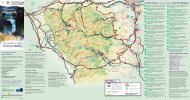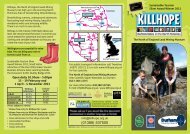How a visit to Killhope can inspire
How a visit to Killhope can inspire
How a visit to Killhope can inspire
You also want an ePaper? Increase the reach of your titles
YUMPU automatically turns print PDFs into web optimized ePapers that Google loves.
UNIT 12: HOW DID LIFE CHANGE IN OUR LOCALITY IN VICTORIAN TIMES<br />
Using <strong>Killhope</strong>: <strong>Killhope</strong> is set in its landscape, and all around it is evidence of Vic<strong>to</strong>rian habitation.<br />
Children <strong>can</strong> explore the his<strong>to</strong>ry of <strong>Killhope</strong>, and the area, seeing where people used <strong>to</strong> live, how<br />
lead was initially mined at the reconstructed workings in <strong>Killhope</strong>’s woodland, and how this changed<br />
when Park Level Mine was constructed in 1853. <strong>Killhope</strong> also shows how technology changed over<br />
the next 50 years, with the introduction of different types of mining equipment. It also gives children<br />
the opportunity <strong>to</strong> see how the living conditions, and the landscape changed, as different<br />
regulations were introduced. For example, 3 different types of powder s<strong>to</strong>res <strong>can</strong> be seen at<br />
<strong>Killhope</strong>, as the regulations regarding the s<strong>to</strong>rage of gunpowder changed. <strong>Killhope</strong> also offers<br />
children the opportunity <strong>to</strong> experience the conditions the miners would have worked and lived in,<br />
and <strong>to</strong> carry out some of the tasks for themselves, making it a memorable experience. <strong>Killhope</strong>’s<br />
main strength for this unit is that it provides a real-life context for what the children will learn about.<br />
LEARNING OBJECTIVES POSSIBLE ACTIVITIES LEARNING OUTCOMES<br />
• To find out about the<br />
past<br />
• To select and record<br />
information relevant <strong>to</strong> a<br />
chosen <strong>to</strong>pic.<br />
Who lived here in 1841?<br />
• Ask the children <strong>to</strong> find 1841on the<br />
timeline. Ask they who they think<br />
might have lived in the local area in<br />
1841, and how they might find out.<br />
• Look around the site and discover<br />
who lived here in 1841.<br />
Who lived and worked here in 1891? What has changed since 1841 and why?<br />
• To make comparisons<br />
that illustrate changes<br />
within the Vic<strong>to</strong>rian<br />
period.<br />
• To give reasons for<br />
these changes.<br />
• To identify characteristic<br />
features of Vic<strong>to</strong>rian<br />
transport and industry.<br />
• Look around the site <strong>to</strong> discover<br />
what changed since 1891. Use the<br />
Graham letters <strong>to</strong> learn about a<br />
family who emigrated. On the<br />
Washing Floor technology<br />
changed, and so did employment<br />
levels at the site. Discover why!<br />
• Discuss what has changed since<br />
1841? Are people still living in the<br />
same houses? Discuss why<br />
changes may have taken place.<br />
• Show the children changes in<br />
transport and industry, <strong>Killhope</strong><br />
contains repaired mining<br />
technology from different stages in<br />
the mine’s his<strong>to</strong>ry, and the old<br />
wagon tracks that led <strong>to</strong> smelting<br />
mills before the roads were<br />
constructed are still visible from the<br />
site.<br />
• Discuss whether changes in<br />
transport or industry were the most<br />
important.<br />
• Identify changes between<br />
1841 and 1891.<br />
• Speculate about possible<br />
reasons for change.<br />
24







